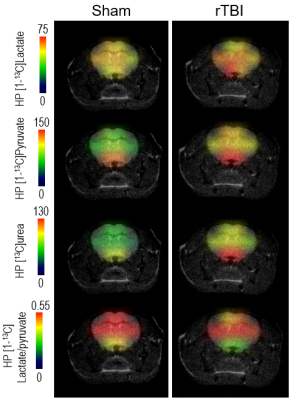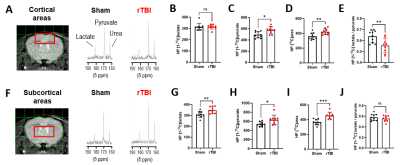Caroline Guglielmetti1,2, Kai Qiao1,2, Brice Tiret1,2, Karen Krukowski1,3, Amber Nolan3,4, Susanna Rosi1,3,5,6, and Myriam M. Chaumeil1,2
1Department of Physical Therapy and Rehabilitation Science, University of California San Francisco, San Francisco, CA, United States, 2Department of Radiology and Biomedical Sciences, University of California San Francisco, San Francisco, CA, United States, 3Brain and Spinal Injury Center, University of California San Francisco, San Francisco, CA, United States, 4Department of Pathology, University of California San Francisco, San Francisco, CA, United States, 5Department of Neurological Surgery, University of California San Francisco, San Francisco, CA, United States, 6Weill institute for Neuroscience, University of California San Francisco, San Francisco, CA, United States
1Department of Physical Therapy and Rehabilitation Science, University of California San Francisco, San Francisco, CA, United States, 2Department of Radiology and Biomedical Sciences, University of California San Francisco, San Francisco, CA, United States, 3Brain and Spinal Injury Center, University of California San Francisco, San Francisco, CA, United States, 4Department of Pathology, University of California San Francisco, San Francisco, CA, United States, 5Department of Neurological Surgery, University of California San Francisco, San Francisco, CA, United States, 6Weill institute for Neuroscience, University of California San Francisco, San Francisco, CA, United States
Mild
repetitive traumatic injury (rTBI) is associated with decreased HP
lactate/pyruvate and pyruvate dehydrogenase activity in cortical areas three
months after injury in a mouse model. HP 13C pyruvate and HP 13C
urea increased in the entire brain in rTBI. T2 and T1 MRI failed to detect
injury.

Representative
HP metabolites heatmaps from a Sham and a rTBI mouse showing higher [1-13C]lactate
levels in rTBI in subcortical areas. Higher HP [1-13C]pyruvate and
HP 13C urea levels can be observed in the entire brain of rTBI
compared to Sham. Heatmaps of HP [1-13C]lactate/pyruvate ratio show
lower values in cortical areas in rTBI.

(A) T2 image and overlaid grid
used for HP 13C MRSI analyses, red voxels indicate cortical areas
and their corresponding HP 13C spectra for Sham and rTBI.
Quantitative analyses of HP 13C (B) lactate, (C) pyruvate,
(D) urea and (E) lactate/pyruvate for cortical areas. (F) T2
weighted image and HP 13C grid, red voxels indicate subcortical
areas and corresponding HP 13C spectra. Quantitative analyses of HP 13C
(G) lactate, (H) pyruvate, (I) urea and (J)
lactate/pyruvate for subcortical areas.
